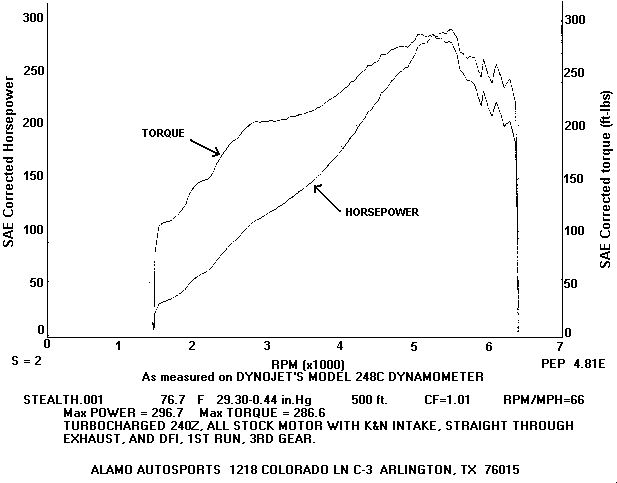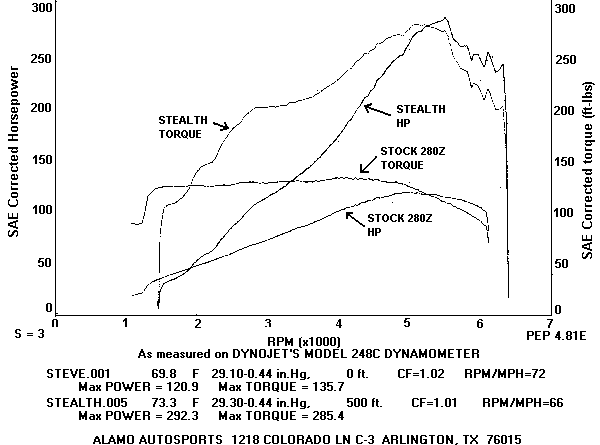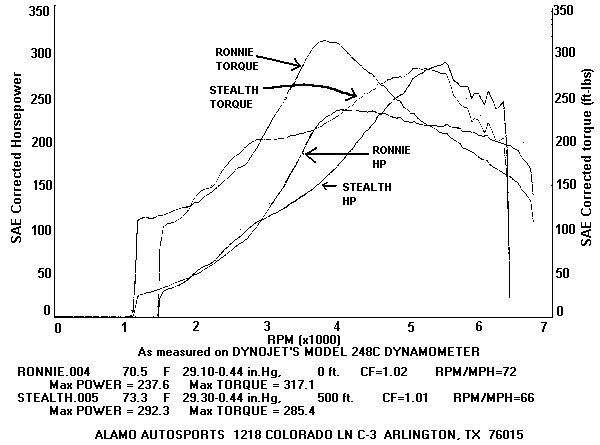As I promised, we have lots of dyno graphs to looks at. Most are of the "Stealth" with other Z's thrown in for comparison, but we'll get to that in a minute.
I've got to admit, I was very anxious before the run. This would be my first run ever on the chassis dyno, and I would be running my baby. The funniest thing is, I couldn't get over the urge to fasten my seat belt! I knew the car was strapped down tight (I did it myself) and it wasn't going to go anywhere, but it just didn't feel right without being belted in (I have since conquered my phobia!). it is definitely an adrenaline rush though. Eight seconds never lasted so long! The run went well, and I gained a wealth of new info. Two things showed up clearly though. One is that my injectors were going static (open all the time) at above 5000 rpm. This is not good, considering 80% duty cycle is generally the most an injector will accurately run at. The second is my old friend "boost creep", sigh...
A few words about reading the graphs. I like to talk about torque a lot. Torque is the twisting force the engine produces; it's what motivates you down the road. Most racers and engine builders will tell you to worry about torque and horsepower will follow. Although not technically true, I like to think of torque multiplied by RPM equaling horsepower. Oh, by the way, the torque and HP graphs will always cross at 5250 RPM (it's a mathematical thing).
Now to walk through the first graph: we have a 1500 RPM start or 'punch'. You can see the initial rise in torque, then at about 1700 RPM the onset of boost (5 PSI shows on the boost gauge by 1800 RPM). The initial smooth rise of torque continues until about 2800 RPM, and boost is still holding at 5.5 PSI (the wastegate setting). Torque settles a bit as the engine uses more air as RPM rises. At 3800 RPM the curve starts upward again. This is where the wastegate can no longer hold, and the boost starts rising again to a peak of 11 PSI at 4800 RPM. Around 5200 RPM bad things start to happen. This is where the injectors are going static and you will see a dramatic and jagged drop in horsepower and torque. I believe I'm running out of fuel here. I say that cautiously as you have to be careful reading the graphs; a lean fuel mixture creating a miss can be mistaken for a bad ignition system creating a miss.
 |
The second graph shows the ""Stealth" compared to a relatively stock 280Z. Notice the nice flat (I'll bet boring) torque curve of the naturally aspirated engine vs. forced induction.
 |
The third graph shows the 'Stealth' compared to the 280Z Turbo of Ronnie Jackson. Ronnie is an electrician and has come up with some 'innovative' fuel management modifications. His 280Z has what he describes as a "junkyard (turbo Z) engine" in it with a stock turbo and 2.5" exhaust. Instead of an intercooler, he is using 50/50 water/methanol injection which he claims is good to around 18-20 PSI of boost! He'll tell you with a sheepish grin though that this is not the first turbo motor in his car. But take a good look at the torque curve - yea-haw! It became apparent how he can smoke the tires through second gear (one of his favorite pastimes I think!?). Around 4000 RPM, torque and hp really drop off dramatically. We think this is due in part to not quite enough fuel and very probably the turbo running out of air.
 |
To remedy my fuel problem I had two options: 1) larger injectors, or 2) raise fuel pressure. The more economical of the two is fuel pressure. Thus I removed the fuel pressure regulator (which is a stock ZX/ZXT part), set up a test bench and "modified" it to increase fuel pressure by 10 PSI (from a stock of 36 PSI to 46 PSI). One point about fuel pressure - in raising the pressure on my test bench using a non-turbo FI pump, the flow dropped nearly in half with the 10 PSI increase. At a simulated 10 PSI of boost (56 PSI fuel pressure) the flow stopped!! Kind of shows the need for a high pressure and high volume pump. This was with a 12V source, rather than the 13.5V the pump would hopefully be getting with the engine running. In fact, a company named Kenne Bell has a new device called a "Boost-A-Pump"; that increases voltage being supplied to any fuel pump, which in turn increases the pump's output by up to 50%! If nothing else (I already have a high output pump), I think I'm going to run a larger diameter power wire than the factory back to my pump.
I did manage to disassemble and port the turbo exhaust housing again, this time cutting apart the wastegate actuator arm to gain access to the port. The disappointing news is that after all that work, it only made a small difference in my boost creep problem (heavy sigh...). I was hoping to get the boost under control before continuing with any further upgrades - from this point I guess I'll have to just 'proceed with caution'. Newsletter deadlines didn't allow for an 'after' dyno run for this issue, but I'll stick it in next month's article.